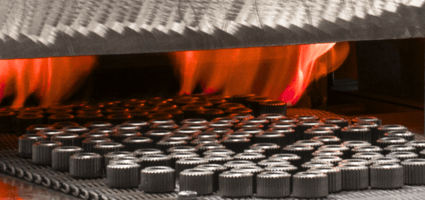Some manufacturing veterans view processes like machining, casting, and stamping as the only way to...
Compaction Process in Powder Metallurgy: Property Benefits

Today the manufacturing world understands the compactibility and compressibility of powdered metals much better than the “old days” (~20 years ago). This growth in knowledge has expanded the industry’s opportunities to produce complex, structural-grade components.
Understanding powder compaction is crucial to controlling properties such as component density, shape, size, porosity, and hardness. To help modernize your part's performance and cost-efficiency, let's review the powder compaction process in powder metallurgy:
- Its role within the PM process
- Die compaction introduction & tooling functions
- Die pressing process
- Factors that influence compaction
- How to improve compressibility
Compaction’s Role in the Powder Metallurgy Process

Each step of the powder metallurgy process involves many variables that impact the performance and longevity of your final component. A familiarity with the overall process will help you better understand how compaction’s role is pivotal to consistency and precision.
The conventional die pressing and sintering process includes four steps:
- Mixing the powder: Elemental or alloy metal powders are mixed with additives, such as lubricants or binders, to produce a uniform material blend.
- Compaction: A press puts the material under extreme pressure to form a compressed, "green" part with the desired shape.
- Sintering: A controlled-atmosphere furnace heats the powder to a temperature below the base metal's melting point to form metallurgical bonds, increasing strength and integrity.
- Secondary operations: If necessary, machining, heat treatment, and surface treatments add value by further refining performance or dimensions.
Read more about the PM process here.
Die Compaction Introduction and Tooling Functions
In powder metallurgy, the compaction process is the shaping, deformation, and densification of a material via pressure from a tooling set. Die compaction, the most common means for shaping and densifying a powder, applies pressure through upper and lower punches to press a powder into a “green,” pre-sintered compact.

A compaction tooling set is designed for each custom component. A basic set of compaction tooling includes a die cavity, upper and lower punches, and a core rod. Tool designers create sets around powder specifications, press designations, and a part’s shape. As you can see above, there are sets for both single-level and multilevel tooling.
The Die Compaction Process
In the die pressing process, compaction is a continuous cycle. Tooling motions start in the fill position and then move through the compaction and ejection stages.
The end result is a compacted “green” part. The component's density and strength during this stage are referred to as green density and green strength. For reference, these compacts have similar green strengths to Life Savers candy and Aspirin tablets.
Factors That Influence Powder Compaction
A key to understanding the aspects that influence compaction is knowing about compressibility. Compressibility is the capacity of a metal powder to undergo densification during applied pressure in a closed die. A material's compressibility is impacted by several factors the manufacturer can adjust to reach optimal conditions.
Particle Shape & Size
By definition, a particle’s size is less than 1 mm. Even at the microscopic level, size matters.
Particle size influences how well materials can be packed together. Particle shape influences flow, packing, and overall compressibility of the material blend during compaction. Irregularly shaped particles tend to pack together better than other shapes during the conventional pressing process.

Chemical Composition
Different alloys and elemental compositions tend to show varying compressibility behaviors. For example, elemental powder blends made with iron, nickel, or copper materials compact more easily than prealloyed materials.
Hardness
The hardness of your chosen material can impact compressibility. Harder materials are more challenging to deform, meaning they’re less compressible. Softer, more ductile particles can deform more easily during compaction.
Lubrication
The presence and amount of lubricants affects how well particles “slide” past each other during compaction (instead of stubbornly staying in place). The proper lubricant and processing can:
- Boost green strength
- Prevent work/strain hardening from heating
- Help with part ejection from the die, maintaining efficiency & shape integrity
- Reduce tooling wear, especially at higher compaction forces
- Increase compressibility
How to Improve Compactibility
Compressibility plays a significant role in the economical and effective production of powder metal components. Specific requirements for improving compactibility may vary based upon your part’s material or application.
Particle size and shape, chemical composition, hardness, and lubrication are all customizable for a smoother pressing process. Your best strategy may include:
- Changing lubricants – A solid lubricant can improve flowability and reduce friction between particles and the die, improving green strength, tool life, and dimensional control.
- Adjusting base material – Using atomized powder helps control particle size & shape consistency in structural components.
- Warm compaction – This reduces the particles' yield strength, allowing for a more deformable material.
Applying Compaction Best Practices to Your Powder Metal Part
Can small changes increase the density – and strength – of your part?
A powder metallurgy expert can look at your application to determine if there are opportunities to improve the performance and life span of your component.
To take full advantage of the powder metal process, visit our blog library and keep learning:
(This article was recently updated with new insights)

.jpg?width=300&height=240&name=Compaction%20Press%20Gear%20Parts%20(1).jpg)



